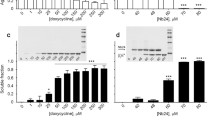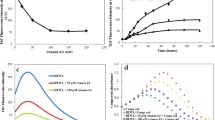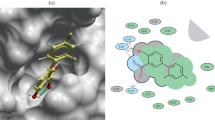Abstract
G555F mutant of Fibrinogen A alpha-chain (FGA) is reported to be associated with kidney amyloidosis. In the current study, we have modelled the G555F mutant and examined the mutation’s effect on the structural and functional level. We have also docked Vitamin C and D3 on the mutant’s amyloidogenic region to identify if these vitamins can bind amyloidogenic regions. Further, we analyzed if they could prevent or modulate amyloid formation by stopping critical interactions in amyloidogenic regions in FGA. We used the wild type FGA model protein as a control. Our docking and molecular dynamics simulation results indicate stronger Vitamin D3 binding than Vitamin C to the amyloidogenic region of the mutant protein. The RMSD, radius of gyration, and RMSF values were higher for the G555F mutant than the FGA wild type protein. Overall, the results support these vitamins’ potential as a therapeutic and anti-amyloidogenic agent for FGA renal amyloidosis.
Graphic abstract







Similar content being viewed by others
References
Sivalingam V, Patel B (2016) Familial mutations in fibrinogen Aα (FGA) chain identified in renal amyloidosis increase in vitro amyloidogenicity of FGA fragment. Biochimie 127:44–49. https://doi.org/10.1016/j.biochi.2016.04.020
Serpell LC, Benson M, Liepnieks JJ, Fraser PE (2007) Structural analyses of fibrinogen amyloid fibrils. Amyloid 14:199–203. https://doi.org/10.1080/13506120701461111
Grateau G, Delpech M (2008) Fibrinogen, amyloid proteins. Wiley, New York, pp 657–666
Hanss M, Biot F (2001) A database for human fibrinogen variants. Ann N Y Acad Sci 936:89–90. https://doi.org/10.1111/j.1749-6632.2001.tb03495.x
Berman H, Westbrook J, Feng Z, Gilliland G, Bhat T, Weissig H, Shindyalov I, Bourne P (2000) The protein data bank. Nucleic Acids Res 28:235–242. https://doi.org/10.1093/nar/28.1.235
Roy A, Kucukural A, Zhang Y (2010) I-TASSER: a unified platform for automated protein structure and function prediction. Nat Protoc 5:725–738. https://doi.org/10.1038/nprot.2010.5
Yang J, Yan R, Roy A, Xu D, Poisson J, Zhang Y (2015) The I-TASSER Suite: protein structure and function prediction. Nat Methods 12:7–8. https://doi.org/10.1038/nmeth.3213
Yang J, Zhang Y (2015) I-TASSER server: new development for protein structure and function predictions. Nucleic Acids Res 43:W174–W181. https://doi.org/10.1093/nar/gkv342
Wu S, Zhang Y (2007) LOMETS: a local meta-threading-server for protein structure prediction. Nucleic Acids Res 35:3375–3382. https://doi.org/10.1093/nar/gkm251
Studer G, Rempfer C, Waterhouse MA et al (2020) QMEANDisCo—distance constraints applied on model quality estimation. Bioinformatics 36(6):1765–1771. https://doi.org/10.1093/bioinformatics/btz828
DeLano WL (2002) Pymol: An open-source molecular graphics tool. CCP4 Newsletter Protein Crystallography 40:82–92
Guex N, Peitsch MC (1997) SWISS-MODEL and the Swiss-PdbViewer: an environment for comparative protein modeling. Electrophoresis 18:2714–2723. https://doi.org/10.1002/elps.1150181505
Kundu D, Umesh Dubey VK (2020) Interaction of selected biomolecules and metabolites with amyloidogenic proteins. J Biomol Struct Dyn. https://doi.org/10.1080/07391102.2020.1760138
Umesh KD, Selvaraj C, Singh SK, Dubey VK (2020) Identification of new anti-nCoV drug chemical compounds from Indian spices exploiting SARS-CoV-2 main protease as target. J Biomol Struct Dyn. https://doi.org/10.1080/07391102.2020.1763202
Pettersen EF, Goddard TD, Huang CC et al (2004) UCSF Chimera—a visualisation system for exploratory research and analysis. J Comput Chem 25:1605–1612. https://doi.org/10.1002/jcc.20084
Kumar P, Henikoff S, Ng PC (2009) Predicting the effects of coding non-synonymous variants on protein function using the SIFT algorithm. Nat Protoc 4:1073–1081. https://doi.org/10.1038/nprot.2009.86
Sim NL, Kumar P, Hu J, Henikoff S, Schneider G, Ng PC (2012) SIFT web server: predicting effects of amino acid substitutions on proteins. Nucleic Acids Res 40:W452–W457. https://doi.org/10.1093/nar/gks539 (Epub 2012 Jun 11)
Singh HB, Deka D, Das D, Borbora D (2016) Computational prediction of the effects of non-synonymous single nucleotide polymorphisms in the human Quinone Oxidoreductase 1 (NQO1). Meta Gene. https://doi.org/10.1016/j.mgene.2016.12.008
Choi Y, Sims GE, Murphy S, Miller JR, Chan AP (2012) Predicting the functional effect of amino acid substitutions and indels. PLoS One 7:46688. https://doi.org/10.1371/journal.pone.0046688
Choi Y (2012) A fast computation of pairwise sequence alignment scores between a protein and a set of single-locus variants of another protein. In: Proceedings of the ACM Conference on Bioinformatics, Computational Biology and Biomedicine (BCB’ 12). ACM, New York, USA, pp 414–417. https://doi.org/10.1145/2382936.2382989
Choi Y, Chan AP (2015) PROVEAN web server: a tool to predict the functional effect of amino acid substitutions and indels. Bioinformatics 31(16):2745–2747. https://doi.org/10.1093/bioinformatics/btv195
Forli S, Huey R, Pique ME, Sanner MF, Goodsell DS, Olson AJ (2016) Computational protein-ligand docking and virtual drug screening with the AutoDock suite. Nat Protoc 11(5):905–919. https://doi.org/10.1038/nprot.2016.051
Venkataesan KS, Shukla KA, Dubey VK (2010) Molecular docking studies of selected tricyclic and quinone derivatives on trypanothione reductase of Leishmania infantum. J Comput Chem. https://doi.org/10.1002/jcc.21538
Morris GM, Olson AJ (1996) Automated docking of flexible ligands: applications of AutoDock. J Mol Recogn 9(1):1–5. https://doi.org/10.1002/(sici)1099-1352(199601)9:1%3c1::aid-jmr241%3e3.0.co;2-6
Raj S, Sasidharan S, Dubey VK, Saudagar P (2019) Identification of lead molecules against potential drug target protein MAPK4 from L. donovani: an in-silico approach using docking, molecular dynamics and binding free energy calculation. PLOS One 14(8):e022133. https://doi.org/10.1371/journal.pone.0221331
Dassault Systèmes (2020) BIOVIA, Discovery Studio Visualiser, v.20.1.0.19295, San Diego
Salentin S et al (2015) PLIP: fully automated protein-ligand interaction profiler. Nucl Acids Res 43(W1):W443–W447. https://doi.org/10.1093/nar/gkv315
Borkotoky S, Banerjee M (2020) A computational prediction of SARS-CoV-2 structural protein inhibitors from Azadirachta indica (Neem). J Biomol Struct Dyn. https://doi.org/10.1080/07391102.2020.1774419
Van Aalten DMF, Bywater R, Findlay JBC et al (1996) PRODRG, a program for generating molecular topologies and unique molecular descriptors from coordinates of small molecules. J Comput Aided Mol Des 10:255–262. https://doi.org/10.1007/BF00355047
Gupta S, Dasmahapatra AK (2020) Destabilisation potential of phenolics on Aβ fibrils: mechanistic insights from molecular dynamics simulation. Phys Chem Chem Phys R Soc Chem Publ. https://doi.org/10.1039/d0cp02459g
Bussi G, Donadio D, Parrinello M (2007) Canonical sampling through velocity rescaling. J Chem Phys 126(1):014101. https://doi.org/10.1063/1.2408420
Kawata M, Nagashima U (2001) Particle mesh Ewald method for three-dimensional systems with two-dimensional periodicity. Chem Phys Lett 340(1):165–172. https://doi.org/10.1016/S0009-2614(01)00393-1
Hess B, Bekker H, Berendsen HJ, Fraaije JG (1997) LINCS: a linear constraint solver for molecular simulations. J Comput Chem 18(12):1463–1472. https://doi.org/10.1002/(SICI)1096-987X(199709)18:12
Kar P, Lipowsky R, Knehct V (2013) Importance of polar solvation and configurational entropy for design of antiretroviral drugs targeting HIV-1 protease. J Phys Chem B 117:5793–5805. https://doi.org/10.1021/jp3085292
Genheden S, Ryde U (2015) The MM/PBSA and MM/GBSA methods to estimate ligand binding affinities. Expert Opin Drug Discov 10(5):449–461. https://doi.org/10.1517/17460441.2015.1032936
Musyoka MT, Kanzi MA, Lobb AK et al (2016) Structure based docking and molecular dynamic studies of Plasmodial cysteine proteases against a South African natural compound and its analogs. Sci Rep 6:23690. https://doi.org/10.1038/srep23690
Berhanu WM, Hansmann UHE (2012) Side-chain hydrophobicity and the stability of Ab16-22 aggregates. Protein Sci 21:1837–1848. https://doi.org/10.1002/pro.2164
Kabsch W, Sander C (1983) Dictionary of protein secondary structure: pattern recognition of hydrogen-bonded and geometrical features. Biopolymers 22:2577–2637. https://doi.org/10.1002/bip.360221211
Gupta S, Dasmahapatra AK (2019) Caffeine destabilises preformed Ab protofilaments: insights from all-atom molecular dynamics simulation. Phys Chem Chem Phys 21:22067. https://doi.org/10.1039/c9cp04162a
Diana A, Michelin O, Zoete V (2017) SwissADME: a free web tool to evaluate pharmacokinetics, drug-likeness and medicinal chemistry friendliness of small molecules. Sci Rep 7:42717. https://doi.org/10.1038/srep42717
Garcia GM, Navarro S et al (2020) Coiled-coil inspired functional inclusion bodies. Microb Cell Fact 19:117. https://doi.org/10.1186/s12934-020-01375-4
Pelassa I, Corà D, Cesano F, Monje FJ, Montarolo PG, Fiumara F (2014) Association of polyalanine and polyglutamine coiled coils mediates expansion disease-related protein aggregation and dysfunction. Hum Mol Genet 23:3402–3420. https://doi.org/10.1093/hmg/ddu049
Buchan DWA, Jones DT (2019) The PSIPRED protein analysis workbench: 20 years on. Nucleic Acids Res. https://doi.org/10.1093/nar/gkz297
Jones DT (1999) Protein secondary structure prediction based on position-specific scoring matrices. J Mol Biol 292:195–202. https://doi.org/10.1006/jmbi.1999.3091
Singh BK, Sarkar N, Jagannadham MV, Dubey VK (2008) Modeled structure of trypanothione reductase of Leishmania infantum. BMB Rep 41:444–447. https://doi.org/10.5483/bmbrep.2008.41.6.444
Lee J, DubeyVK LLM, Blaber M (2008) A logical OR redundancy within the Asx-Pro-Asx-Gly type I β-turn motif. J Mol Biol 377:1251–1264. https://doi.org/10.1016/j.jmb.2008.01.055
Pande M, Srivastava R (2019) Molecular and clinical insights into protein misfolding and associated amyloidosis. Eur J Med Chem 15(184):111753. https://doi.org/10.1016/j.ejmech.2019.111753 (Epub 2019 Oct 7)
Taylor GW, Gilbertson JA, Sayed R et al (2019) Proteomic analysis for the diagnosis of fibrinogen Aα-chain amyloidosis. Kidney Int Rep 4(7):977–986. https://doi.org/10.1016/j.ekir.2019.04.007
Acknowledgement
The infrastructure provided by the Department of Biochemistry, Institute of Medical Sciences, BHU is acknowledged. Financial support by DST, Government of India in the form of Woman Scientist A (WoS-A) research grant [Project no: SR/WOS-A/ LS-478-2017] to MP is also acknowledged. DK acknowledges the research fellowship provided by IIT-BHU. The support and the resources provided by the PARAM Shivay Facility under the National Supercomputing Mission, Government of India at the Indian Institute of Technology, Varanasi are gratefully acknowledged.
Author information
Authors and Affiliations
Contributions
Monu Pande contributed to conceptualisation, validation, formal analysis, resources (docking, simulation, and analysis) writing—original draft, Debanjan Kundu was involved in methodology, resources (docking, simulation, and analysis), and writing—original draft, and Ragini Srivastava contributed to writing, review and editing, and supervision.
Corresponding author
Ethics declarations
Conflict of interest
The authors declare that there is no competing interest or any potential conflict which might have influenced the results of this paper.
Additional information
Publisher's Note
Springer Nature remains neutral with regard to jurisdictional claims in published maps and institutional affiliations.
Supplementary Information
Below is the link to the electronic supplementary material.
Rights and permissions
About this article
Cite this article
Pande, M., Kundu, D. & Srivastava, R. Vitamin C and Vitamin D3 show strong binding with the amyloidogenic region of G555F mutant of Fibrinogen A alpha-chain associated with renal amyloidosis: proposed possible therapeutic intervention. Mol Divers 26, 939–949 (2022). https://doi.org/10.1007/s11030-021-10205-7
Received:
Accepted:
Published:
Issue Date:
DOI: https://doi.org/10.1007/s11030-021-10205-7




